Electronic vs Mechanical Shifting: The Pros and Cons Explained
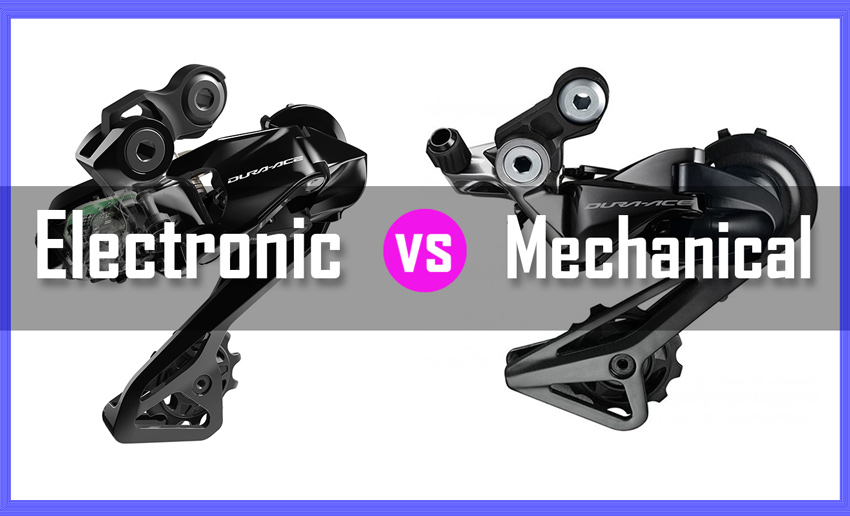
Comparing mechanical vs. electronic bike shifters is a hot debate in the cycling world. In recent years, the quality and reliability of electric shifter systems have improved enough to exceed mechanical shifting in most metrics.
Both have advantages and disadvantages, and the high cost of SRAM, Campagnolo, and Shimano electronic shifting drivetrains is still a major limiting factor for the average rider. Even though electronic groupsets will always be more expensive, it’s time to find out if that extra cost is worth it.
This article will describe each type and discuss the pros and cons of electronic bike shifters to help you make the right choice when you’re on the hunt for a new bike.
Mechanical Shifting Overview
Most cyclists are familiar with using mechanical groupsets. They operate using a steel cable (Bowden cable) which runs down the frame, connecting the shifting levers and derailleurs.
When you press the shifter, this alters the tension on the cable to actuate the derailleur. Then, the derailleur’s movement guides the chain from one chain to the other in the front or up and down the cassette on the back.
How to Shift Gears on a Bike: Gear Shifting Explained for Beginners
This shifting method requires the rider to mechanically perform the gear change by pushing the lever to move the cable, requiring more effort from the rider but providing valuable tactile feedback when shifting.
Mechanical shifting is the most ubiquitous and cheapest system. Almost all manufacturers use these parts across their range of bikes, making them easy to find and convenient to replace. Unfortunately, though, they require more maintenance, and they aren’t as efficient or consistent.
Electronic Shifting Overview
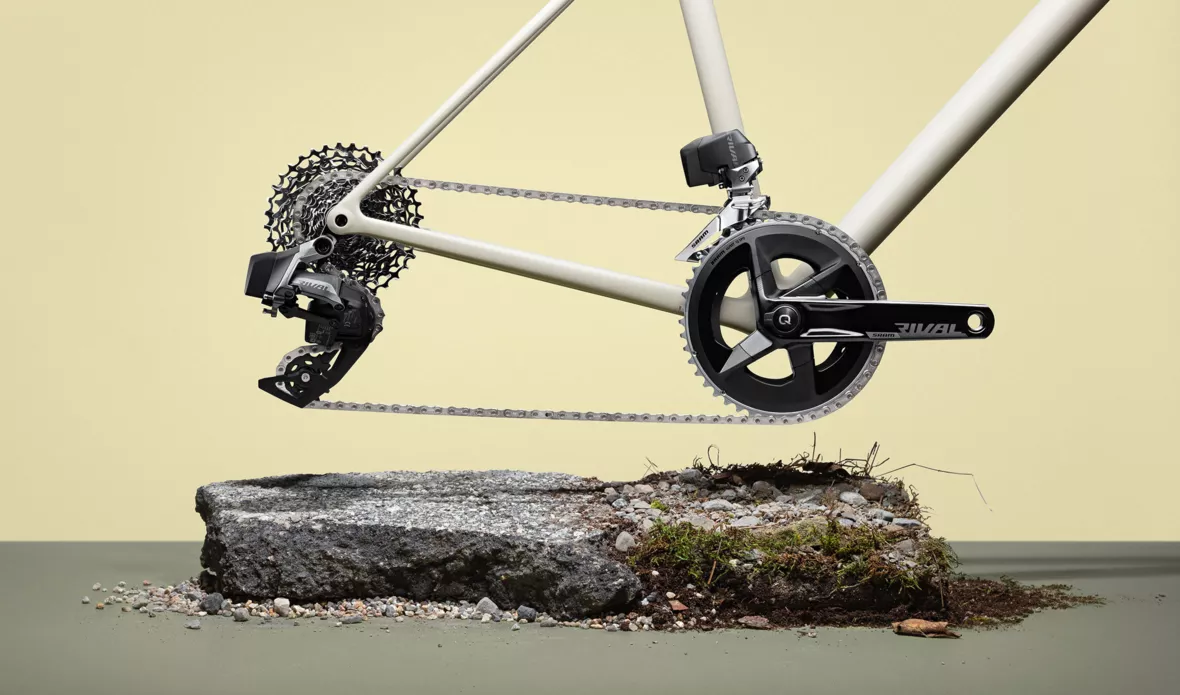
Image source: sram.com
Electronic bike shifters were first introduced in the early ’90s with the release of the Mavic ZAP groupset. Although it ultimately failed, this groupset created the concept that Shimano and Campagnolo later developed in the ’00s. In 2009, the first commercial Shimano electronic shifting Di2 groupset was released.
Today, electronic shift groupsets operate using a mini-computer and electric servo motors in the derailleurs to shift gears (in place of mechanical cables). The shifters connect to the derailleurs using wires (Shimano, Campagnolo) or wirelessly (SRAM). Wired systems use one battery to power both derailleurs, while the wireless design places a separate battery in each derailleur.
Electronic shifting is consistent, smooth, fast, and precise, but still too expensive for many riders.
When you press the shifting lever or button, the computer communicates with the derailleur, causing it to move. This simplicity is what makes electronic shifting so effective. There is no cable friction and no need for regularly indexing the gears. Additionally, the shifting is consistent, smooth, fast, and precise.
The price you pay for this technology is still quite high, but it will continue to drop as manufacturing processes improve and become more widespread. However, it will never be able to match the low prices of mechanical shifting. Another downside is that you must remember to keep your batteries charged as you will not be able to shift if it dies mid-ride.
The Pros of Electronic Bike Shifters
Improves Shifting Precision

Image source: sram.com
As previously mentioned, electronic bike shifters are much more reliable than mechanical ones. They perform the same every time, precisely and smoothly. This characteristic alone makes them more enjoyable to use.
They also perform equally on muddy trails or in wet conditions as cables and cable housing contamination is not an issue. Additionally, you can move along the cassette much faster by simply holding the lever to jump across fully instead of pressing the lever several times, as with a mechanical groupset.
Easier Shifting
With a mechanical groupset, you must provide the force to actuate the derailleur by pushing the lever enough to move it. Although this isn’t particularly difficult, it requires significantly less effort with electronic systems because the servo motor does the heavy lifting.
This characteristic is beneficial if you’re riding in the drops or if your fingers and hands are cold.
Looks Better and Integration Is Easier
For Campagnolo and Shimano electronic shifting, there is simply one wire connected to the levers/buttons that never needs to be replaced, making internal cable routing much easier. Alternatively, SRAM eTap has no wiring. These designs make full headset integration and aerodynamics much easier and give the bike a sleek finish.
Conversely, full integration of mechanical shifting can negatively impact function, as finding an appropriate route through the headset and frame is tricky. Additionally, as the cables wear, you must adjust or replace them, adding further complexity. This issue can deter manufacturers from full cable integration.
Satellite Shifters
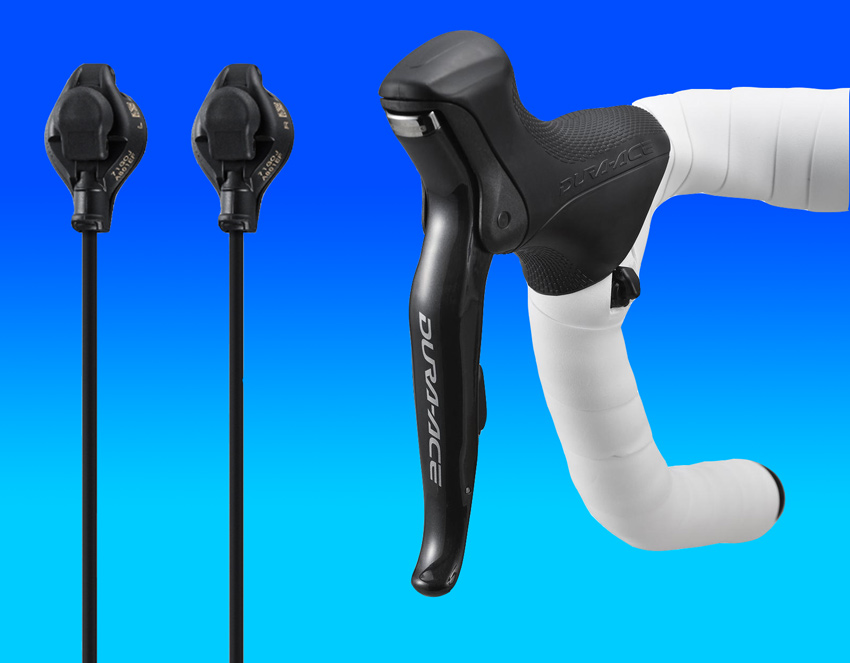
Satellite shifters are a fantastic innovation made possible by electronic shifting. In traditional setups, you have one set of cables linked to the derailleur, limiting you to one set of shifters. However, using a motor connected to a central computer, you can connect a second set to a different position on your handlebars.
Many triathlon and time trial (TT) bikes have satellite shifters on the bull bars to compliment those on the end of the extensions. This allows riders to shift regardless of where their hands are placed. Additionally, many competitive road riders will add a secondary set of shifting buttons on their road bikes to make shifting easier when riding in the drops.
No Chain Rubbing
Most cyclists will be familiar with the noise of the chain rubbing off the inside of the front derailleur when it’s in a diagonal line between the chainring and cassette cog. This rubbing adds friction to the drivetrain, reducing efficiency and causing the chain to deteriorate faster.
How to Adjust a Rear Derailleur for Crisp and Precise Shifting
With an electronic shifting road bike with two chainrings, once indexed correctly at the start, the front derailleur will automatically adjust to match the angle of the chain when you shift along the cassette, eliminating chain rub. Likewise, the SRAM eTap system design eliminates the chance of chain rub completely.
Customize Your Shifting on Your Smartphone
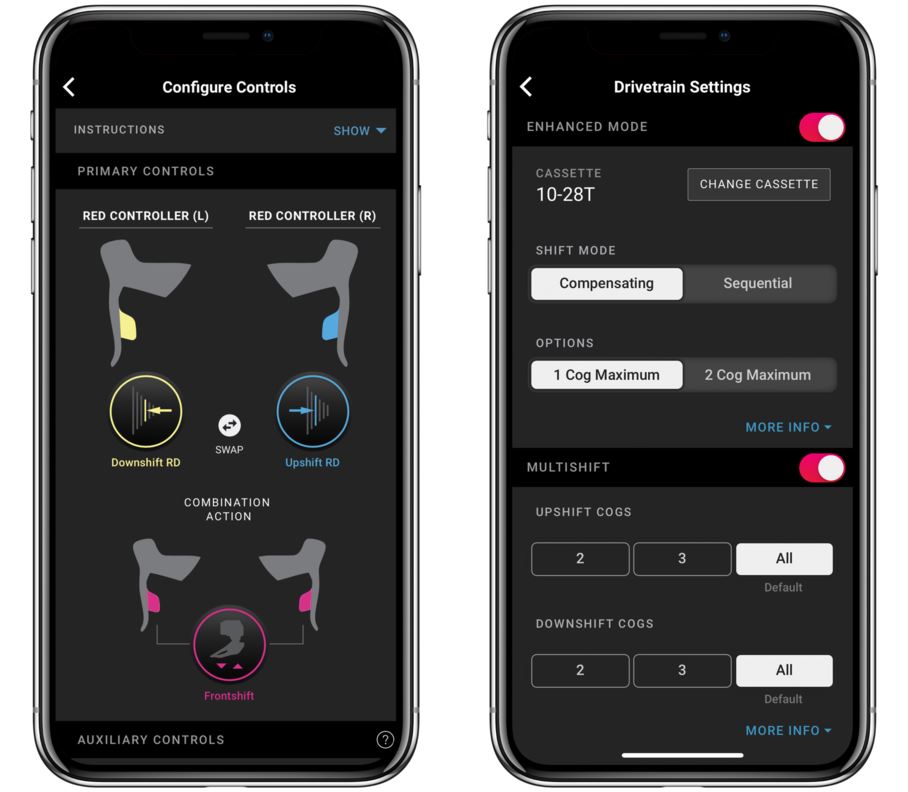
Image source: sram.com
Another excellent feature of electronic groupsets is the ability to customize how the bike shifts. Many new riders struggle with the counterintuitive nature of road bike gearing, so having the opportunity to swap the function of the levers to suit your preferences is a huge bonus.
In addition, electronic groupsets can be set to work in sequence so that you don’t need to operate the front derailleur; the computer will intuitively switch between chainrings for you.
More Durable and Almost Maintenance-Free
As we touched on above, there are fewer cables and fewer moving parts in electronic systems, making them mechanically simple. This simplicity increases durability and essentially eliminates the need for maintenance.
Mechanical cabling is notorious for deteriorating and stretching due to contaminants or simply from normal usage, so eliminating this problem is a huge plus for electronic shifting.
Data Collection
The ability of electronic drivetrains to collect data is a valuable tool for many competitive or tech-minded riders. For example, these systems can record how much time you spend in each gear, the number of shifts on a given ride, and when you shift, syncing the data with your Garmin or Wahoo device.
With this information, riders can learn what gear ratio drivetrain is best for them and adjust their shifting technique to improve performance.
The Cons of Electronic Shifting
Expensive to Buy and Replace
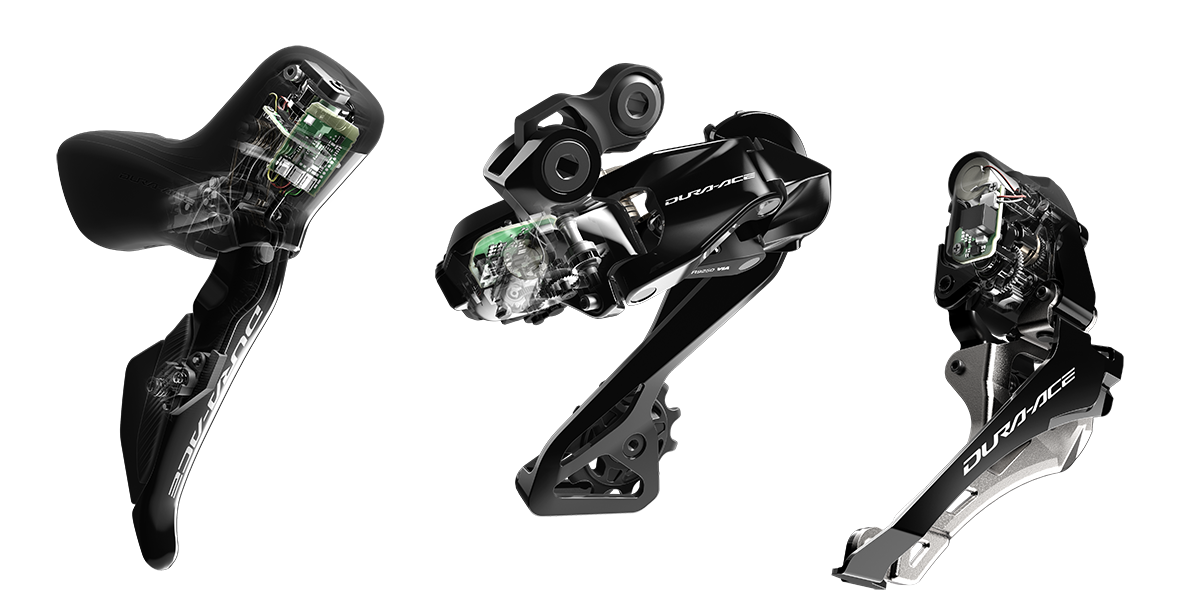
Image source: shimano.com
The most significant disadvantage of electronic shifting technology is the high price. Batteries, mini-computers, and motors will always be more expensive than steel cables. The price difference is highlighted in the cost of Shimano’s complete Ultegra groupset with rim brakes.
- Ultegra Di2 R8050 (electronic) – $1,840
- Ultegra R8000 (mechanical) – $960
In this example, the electronic groupset is almost twice the price of the equivalent mechanical. Unfortunately, this makes the technology out of reach for most riders, as it is typically limited to high-end bikes. However, it’s certainly worth considering the switch if it is within your budget.
Along with the upfront costs, any replacements or repairs will also be expensive, while home repairs will be much harder to execute. For example, a charger replacement alone could cost $100.
Recharging the Battery
The second most significant downside to electronic shifting is the need to charge the battery or batteries, lest you get stuck halfway through a ride with one gear.
How quickly the batteries die depends on the ambient temperature (cold temperatures drain the battery faster) and how often you shift. Thankfully, it’s easy to check the battery level to know when you need to charge.
Many groupset users can go several weeks or months on a single charge, making this less important (although it happens to all users at least once). An added benefit of SRAM is you can swap the batteries between derailleurs, meaning if one dies, you will at least have your full cassette to use.
Heavier
Electronic shifting is heavier than mechanical. This is because motors and batteries weigh more than cables, so you’ll typically find a mechanical groupset is 100-300 grams lighter than the equivalent electronic one. While this isn’t an issue for casual cyclists, it’s an important consideration for competitive riders.
Harder to Troubleshoot
Mechanical shifting is quite easy to troubleshoot and repair with basic bike maintenance knowledge and standard tools. Unfortunately, the same can’t be said of electronic systems. Although they are much less likely to break down or malfunction, it is challenging to identify and fix issues when they arise.
This factor is especially relevant for bicycle tourers or bikepackers who need to be able to repair their bike on the road or find a standard bike shop to do it.
Shimano Shifters are Difficult to Use With Winter Gloves
The final issue, specifically with Shimano electronic shifting, is that the two levers are very close together, making it difficult to push the lever you want when wearing thick gloves. Again, this is a small problem, but it’s incredibly frustrating for riders who frequently ride in cold weather.
The Future of Groupsets
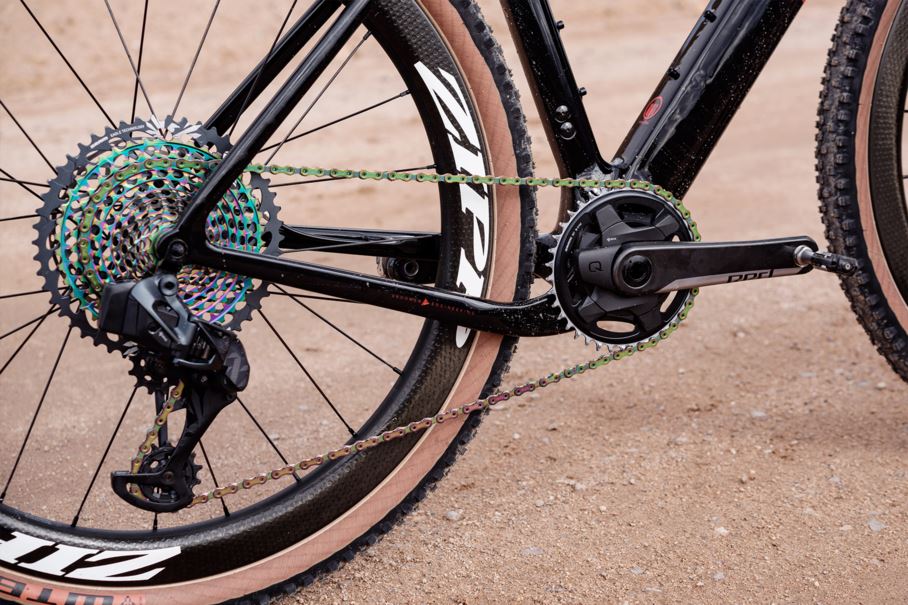
Image source: sram.com
A big question in cycling right now regards the future of mechanical shifting. In Shimano’s most recent launch, they did not release a mechanical version of the Dura-Ace or Ultregra groupsets, opting for electronic only.
This development from Shimano adds to SRAM’s complete move away from mechanical versions of their mid to high-end groupsets, as they haven’t updated their mechanical Red 22, Rival 22, and Force 22 in several years.
With the exclusion of mechanical Ultegra, Shimano likely has a 105 Di2 groupset coming down the pipe to fill the gap, bringing electronic shifting even closer to the general public but raising the average cost of a road bike simultaneously. Nonetheless, it’s improbable they will discontinue their popular 105 mechanical groupsets in the foreseeable future.
From these developments, it seems mechanical shifting may, in the near future, become obsolete in all but entry and mid-level bikes.
However, we hope that the ultimate effect of this change is that electronic shifting becomes more affordable, not that purchasing a good quality bike becomes unaffordable for the average rider.
Final Verdict: Which is Best, Mechanical or Electronic Shifting?
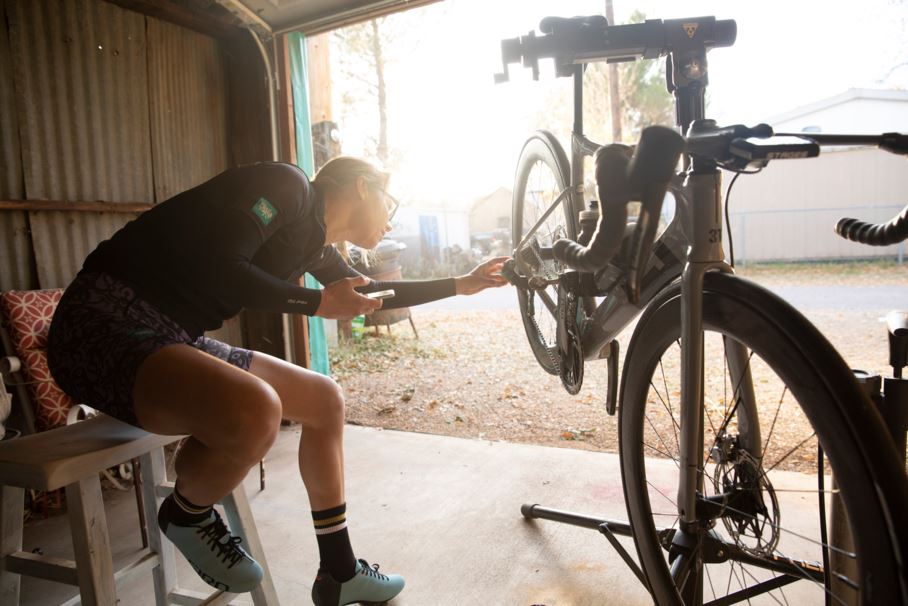
Image source: sram.com
For us, it’s clear that electronic shifting is superior to mechanical. Additionally, the ubiquitous use of electronic shifting in professional cycling confirms that the technology is better for performance.
Electronic shifting is smoother, more reliable, and more precise; the groupsets last longer and require less maintenance, and you can collect data, customize your setup, and add satellite shifters.
Despite improved performance and convenience, the cost is still a huge issue. Unfortunately, most recreational cyclists are not able or willing to pay the price of an electronic groupset that costs more than most entry-level bikes. In addition, you must remember to charge your batteries, and you are more reliant on the bike shop if anything goes wrong.
All things considered, we think it’s worthwhile upgrading to an electronic groupset if it fits your budget; however, today’s mechanical shifting is excellent in most ways as well and is perfectly adequate for recreational cyclists.
RELATED
Shop Electronic Shifting Systems on Jenson USA




